Abstract
The assignments structures of the four 1:1 pipemidic acid (pipH)–magnesium(II), calcium(II), zinc(II), and iron(III) complexes, [Mg(pip)(H2O)3(Cl)].6H2O, [Ca(pip)(H2O)3(Cl)].2H2O, [Zn(pip)(H2O)3(Cl)].4H2O, and [Fe(pip)(H2O)2(Cl)2].6H2O, (where pip = deprotonated pipemidic), were synthesized through the chemical reactions of MgCl2.6H2O, CaCl2.2H2O, ZnCl2, and FeCl3.6H2O metal salt chlorides with pipH chemotherapeutic agent ligand in a methanolic solvent. The microanalytical analysis CHN, conductance, (infrared (FTIR) and electronic (UV–Vis.)) spectra, and thermogravimetric measurements (TG) have been utilized to discuss the solid isolated complexes. The X-ray powder diffraction (XRD) analysis and the transmission electron microscopy (TEM) confirm the nanostructured form of the synthesized pip complexes. The deprotonated pipH ligand is coordinated to Mg(II), Ca(II), Zn(II), and Fe(III) metal ions through the two oxygen atoms of the carbonyl (quinolone group) and carboxylic group. The thermodynamic parameters (energy, E*), (entropy, ΔS*), (enthalpy, ΔH*), and (Gibbs free energy, ΔG*) of activation have been estimated based on thermogravimetric curves using “Coats–Redfern and Horowitz–Metzeger non–isothermal” methods.
1. Introduction
A pyridopyrimidine chemotherapeutic agent derivative of piperidic acid, pipemidic acid (pipH, Figure 1), has an action against both Gram-negative and certain Gram-positive bacteria. In comparison to pyromedic acid and nalidixic acid, pipemidic acid is more active, and it also has a reasonable amount of action against pyromedic acid- and nalidixic acid-resistant bacteria. A pyridopyrimidine, pipemidic acid is a 5-oxo-5,8-dihydropyrido[2,3-d]pyrimidine-6-carboxylic acid that has an ethyl group at position 8 and a piperazine-1-yl group at position 2 replaced. A broad-spectrum chemotherapeutic agent used to treat infections of the biliary, digestive, and urinary tracts. It has a role as an antibacterial drug and an inhibitor of DNA synthesis. It is a monocarboxylic acid, an amino acid, an N-arylpiperazine, a pyridopyrimidine, and a quinolone chemotherapeutic agent.
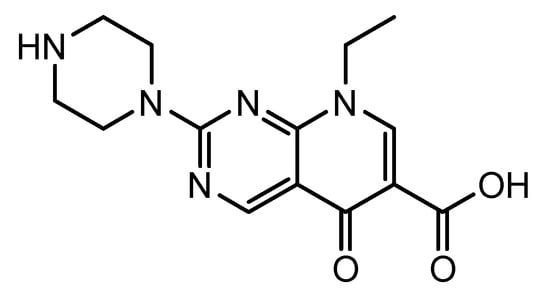
Figure 1.
Molecular structure of pipemidic acid (pipH).
It is worth noting that the marketing authorization of pipemidic acid has been suspended throughout the EU due to the adverse side effects [1]. A special focus has been placed on how metal ions interact with antibiotics when discussing how medications and cations of metals interact in biochemical processes. A family of medications known as the Cross-reaction of antibiotics with cations of metals has been extensively employed in medicine to treat both people and animals [2]. Particularly, the relationship among beta-lactam antibiotics like “cephalexin”, and transition metals has been studied using a variety of physical, chemical, and spectroscopic approaches as well as extensive biological data [3,4,5,6]. When administered in the form of metal complexes, many medications have altered pharmacokinetic and toxicological characteristics. Copper(II), which has been proven effective against various illnesses, including cancer, rheumatoid arthritis, gastric ulcers, and TB, may be the most thoroughly investigated cation in this area [7,8,9,10]. Since nalidixic acid’s discovery around 4 decades ago, the number of medications belonging to the quinolone family has increased exponentially. Since then, this family’s exponential development has created over 10,000 mimics [11]. The chemistry of these medicines’ coordination with biologically and pharmacologically relevant metal ions is quite interesting. The top member of the first-generation quinolone family was thought to be pipemidic acid. Crystal structure determination and production of quinolone derivative-containing metal complexes have been the subject of several investigations [12,13,14,15]. Quinolone chemotherapeutic agents have a number of potential roles in complex formation [16,17,18,19,20]. Only the electrostatic interaction between the drug and the metal ions is seen in these complexes in the event of isolation because they often comprise single and/or double-protonated quinolones that can bind to the metal ion [16,17,18]. However, [19,20,21] discovered that neutral quinolones may form simple complexes in the zwitterionic state (bidentate chelate). Quinolones are also capable of serving as binding bridges, which allows them to create polynuclear complexes [20,21]. Understanding the drug–metal ion interaction and the possible pharmacological applications of a 1:1 molar ratio metal complex with quinolone chemotherapeutic drug agents is crucial. This work reports the isolation and characterization of the complex magnesium, calcium, zinc, and iron cations. The hypothesized structures of the complexes produced by this reaction were deduced using FTIR spectroscopy, electronic spectra, and thermogravimetric analyses.
2. Experimental
2.1. Chemicals
All chemicals and reagents mentioned in this article (MgCl2.6H2O, CaCl2.2H2O, ZnCl2, FeCl3.6H2O, and pipemidic acid in Figure 1) were of the highest quality and purchased from “Sigma-Aldrich Co. (St. Louis, MO, USA)”. Solvents were used as received without more purifications.
2.2. Pipemidic Acid Complexes’ Synthesis
A methanolic fluid of 1 mmol metal salt chlorides (MgCl2.6H2O, CaCl2.2H2O, ZnCl2 and FeCl3.6H2O) and 1 mmol of pipemidic acid drug (pipH) were dissolved to form homogeneous mixtures. The complex solutions were neutralized at pH ~ 7–8 using a few drops of NH3 solution; then, the mixtures were refluxed with contentiously stirring for three hours. All colored combinations were then cooled to ambient conditions until they aggregated and could be filtered, washed several times with hot CH3OH to get rid of the unreacted portions, and left to dry at 75 °C. Using TLC plates, the purity of pip complexes was examined. There have been several unsuccessful trials to produce one pure crystal appropriate for “X-ray crystallography”. These solid complexes are isolated with the anhydrous statement and high melting points due to thermal stabilities. Nevertheless, the spectral and thermogravimetric outcomes could be appropriate to propose the envisaged structures of arrangement for synthesized “[Mg(pip)(H2O)3(Cl)].6H2O, [Ca(pip)(H2O)3(Cl)].2H2O, [Zn(pip)(H2O)3(Cl)].4H2O, and [Fe(pip)(H2O)2(Cl)2].6H2O”, (where pip = deprotonated pipemidic) drug complexes (Figure 2).

Figure 2.
Suggested structures of pipemidic acid (pip)–magnesium, calcium, zinc, and iron (III) drug complexes (M = MgII (x = 6), CaII (x = 2), and ZnII (x = 4)).
2.3. Instrumentals
1. The elemental analyses of carbon, hydrogen and nitrogen contents were performed by the microanalysis unit at Cairo University, Egypt, using a Perkin Elmer CHN 2400 (USA).
2. The molar conductivities of freshly prepared 1.0 × 10−3 mol/cm3 dimethyl sulfoxide (DMSO) solutions were measured for the soluble pipemidic acid complexes using the Jenway 4010 conductivity meter.
3. The infrared spectra with KBr discs were recorded on a Bruker FT-IR Spectrophotometer (4000–400 cm−1) with a resolution of 4 cm−1 with 50 successive scans.
4. UV–Vis. absorption spectra by UV2 Unicam UV/Vis Spectrophotometer, DMSO solvent, 800–200 nm range, quartz cell of 1.0 cm path length.
5. Magnetic susceptibility measurements of pipemidic acid complexes were taken at room temperature (25 °C) using a Sherwood Scientific Magway MSB MK1 model magnetic balance by the Gouy method using Hg[Co(SCN)4] as the calibrant.
6. The thermal studies TG/DTG–50H were carried out on a Shimadzu thermogravimetric analyzer under N2 gas till 800 °C; the rate of heating was kept at 10 °C/min.
7. X-ray powder diffraction patterns for pipemidic acid and its complexes were collected on a Philips X’pert Pro diffractometer in transmission mode with focusing mirror and 1-D PSD detector. The compounds were finely grounded in the mortar and loaded into capillaries (1 mm diameter). The patterns were collected at 25 °C using CuKα radiation (counting time: 9 s/step; 2θ ranges: 4–90°).
8. Transmission electron microscopy (TEM) and high-resolution transmission electron microscopy (HRTEM) images were recorded with a Jeol JEM-100s scanning transmission electron microscope. The morphology of the samples was examined in transmission electron microscopy operating at voltage of 80 kV.
3. Results and Discussion
3.1. Microanalytical and Conductance Measurements
The microanalytical and physical results of the pipemidic acid (pip) coordinated complexes are mentioned as follows: both theoretical and experimental elementary data are well agreed (Table 1).

Table 1.
Microanalytical and physical data of pipemidic acid complexes.
These findings showed that the ligand had a 1:1 molar ratio of coordination to the complex cations of magnesium, calcium, zinc, and iron. In the air, any construct that has been created is stable. Solid pip complexes are insoluble in water, EtOH, CHCl3, acetone, and cyclohexane. The complexes are substantially more stable than the ligand, as evidenced by the freezing temperatures of the complexes being greater than those of the pipH ligand. The complexes’ molar conductance values (estimated in 10−3 M DMSO solvent at ambient conditions) lay in the range of 18–28 Ω−1cm2mol−1 at 25 °C, which indicates that all complexes have a non-electrolytic nature [22]. Based on the deprotonation of the carboxylic group or maybe anion exhibits inside the chelating sphere, these result data are attributed to the lack of chloride ions. So, by comparing the degree of ionization of the complexes with experimental values of electrolyte materials, it was possible to verify the presence of Cl (ions inside the coordination sphere) [22]. According to this result date, the chlorine atoms are located inside the coordination sphere, which was tested using AgNO3 reagent. The percentage of metal ions (magnesium, calcium, zinc, and iron) was calculated using the gravimetry approach in the form of stable metal oxides.
3.2. Infrared Assignments
The infrared spectral regions were identified by the comparison of complexes’ spectra to those of the free pipH ligand (Figure 3 and Table 2). The infrared spectra of the new complexes, “[Mg(pip)(H2O)3(Cl)].6H2O, [Ca(pip)(H2O)3(Cl)].2H2O, [Zn(pip) (H2O)3(Cl)].4H2O, and [Fe(pip)(H2O)2(Cl)2].6H2O”, (Figure 2) within the most important region in the infrared spectra of these four complexes and the pipemidic acid-free ligand (~1800–1200 cm−1) are selected and assigned in Table 1 and displayed in Figure 3A–E. The assignments data of (pip)–magnesium, calcium, zinc, and iron (III) drug complexes show no absorption band at ~1770 cm−1, which is characteristic of the stretching vibration ν(C=O) of the carboxylic group, which is suggestive of the contribution of the carboxyl group in the matching with the metal ion. The peak at 1618-to−1607 cm−1 is present in the spectral data of the pipemidic acid complexes and can be allocated to the asymmetric stretching vibration of the carboxylate group, νas(COO−). The spectra of Mg(II), Ca(II), Zn(II), and Fe(III) complexes also have a medium-to-strong intensity band within the 1421-to−1351 cm−1 region. Because of its significance in interpreting the symmetric vibration of the vs. (COO−) group, this band is absent from the spectra of pipH. The criteria that can be utilized to discriminate between the three binding states of the carboxylate complexes have been investigated by Deacon and Phillips [23,24,25,26,27,28,29]. These prerequisites are (i) Δν > 200 cm−1 (where Δν = [νas(COO−) − νs(COO−)]) for which the same connection is observed in the case of unidentified carboxylato complexes; (ii) bidentate or chelating carboxylato complexes exhibit Δν appreciably less than ionic values(Δν < 100 cm−1); and finally, (iii) bridging complexes reveal Δν equivalent to ionic values (Δν ~ 150 cm−1). The noticed Δν for the (pip)–magnesium, calcium, zinc, and iron (III) drug complexes are 217, 263, 256, and 252 cm−1, respectively, which endorse unidentate chelation of the COO−. The infrared spectral information of the pipH free ligand reveals a band at 1628 cm−1 due to the widening vibration of R2CO of pyridopyrimidine moiety. This band was shifted to a lower wavenumber (1557-to−1537 cm−1), which indicated that the oxygen of the carbonyl group is involved in the coordination of the metal ions [30]. The assignments of the widening vibrations of ν(M–O) in structures are observed within the “500–600 cm–1” range [30]. The interplay of elements of Mg(II), Ca(II), Zn(II), and Fe(III) complexes are well-known in an octahedral geometry.
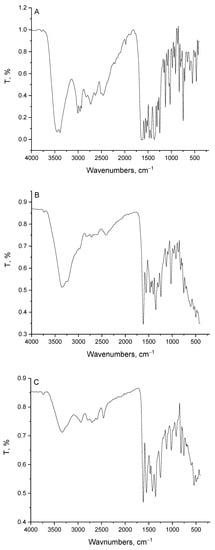
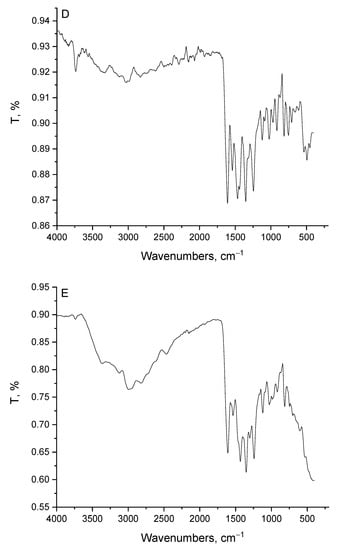
Figure 3.
Infrared spectra of (A): pipH free ligand and its complexes (B): Mg(II), (C): Ca(II), (D): Zn(II), and (E): Fe(III).

Table 2.
FTIR frequencies (cm−1) and assignments of pipH free ligand, pip–magnesium, calcium, zinc, and iron (III) drug complexes.
3.3. Electronic Spectral Data of [Fe(pip)(H2O)2(Cl)2].6H2O Complex
Iron’s spectral data of [Fe(pip)(H2O)2(Cl)2].6H2O complex display bands at 455 and 348 cm–1 assigned to 6A1g→4T2g (G) and 6A1g→4Eg (G) transitions, respectively, in an octahedral geometry [31]. The magnetic moment value is at 4.80 BM, which agrees with iron’s high spin octahedral configuration (III). The Mg(II), Ca(II), and Zn(II) complexes are diamagnetic and were found to have an octahedral geometry.
Powder X-ray Diffraction and TEM Morphology
The X-ray powder diffractions of [Mg(pip)(H2O)3(Cl)].6H2O, [Ca(pip)(H2O)3(Cl)].2H2O, [Zn(pip)(H2O)3(Cl)].4H2O, and [Fe(pip)(H2O)2(Cl)2].6H2O (where, pip = deprotonated pipemidic) solid complexes 1–4 are shown in Figure 4. Crystalline to amorphous states are seen in these diffraction patterns. Using the Debye–Scherrer formula (Equation (1)), the particle size (D) of pip complexes 1–4 was estimated from the principal diffraction patterns of each obtained compound [32,33].
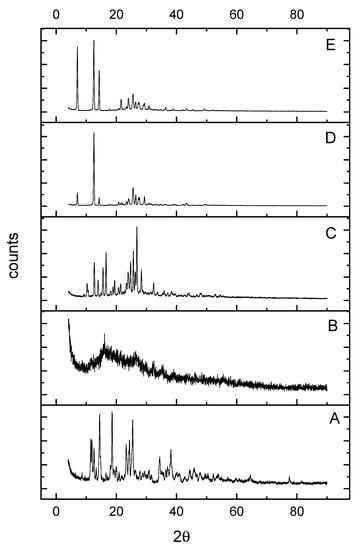
Figure 4.
X-ray powder diffraction patterns of (A): pipH, (B): Mg(II), (C): Ca(II), (D): Zn(II), and (E): Fe(III)–pip complexes.
Cu K radiation has an X-ray wavelength (λ) of 1.5418 Å; K is constant and is considered to be 0.94, the full width at half maximum (FWHM) of a significant intensity peak (a peak with 100% relative intensity), and the peak position. According to the Deby–Scherrer formula, the grain sizes for the Mg(II), Ca(II), Zn(II), and Fe(III) complexes were 2, 18, 17, and 37 nm, respectively.
Table 2 contains a list of the gathered XRD data, including 2θ, strengths, and d-spacing. The production of high-quality complexes is indicated by the dislocation density (δ), which was calculated from Equation (2) [34] and presented in Table 3.

Table 3.
Data on crystallite diameters (D), dislocation density (δ), 2, intensities, and d-spacing of pip complexes 1–4 were acquired using XRD.
TEM photos of pip complexes 1–4 (Figure 5A–D) confirm the presence of spherical NPs, which appeared as black spots.
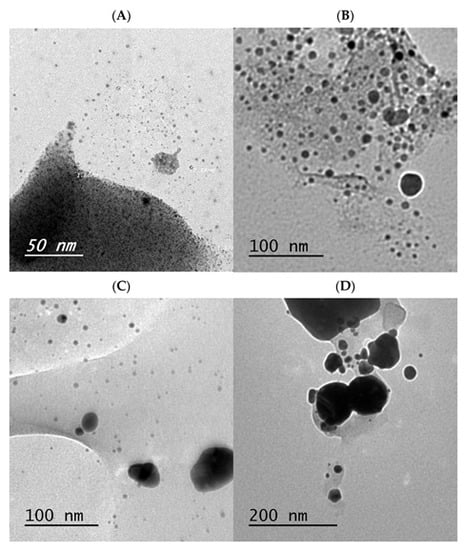
Figure 5.
TEM images of (A): Mg(II), (B): Ca(II), (C): Zn(II), and (D): Fe(III)–pip complexes.
3.4. Thermal Studies
The [Mg(pip)(H2O)3(Cl)].6H2O, [Ca(pip)(H2O)3(Cl)].2H2O, [Zn(pip)(H2O)3(Cl)].4H2O, and [Fe(pip)(H2O)2(Cl)2].6H2O, (where, pip = deprotonated pipemidic) solid complexes 1–4 are stable at room temperature. These complexes were discussed using thermogravimetric (TGA) examination from room conditions to 500 °C under N2 gas. The Resketched TGA Plot showed the percent mass loss against temperature (°C) (Figure 6). In Table 4, along with evolved moiety and theoretical percentage mass losses, the temperature variations and mass percentage losses of the breakdown processes are listed. The overall mass loss from the TGA curves is 92.96% for Mg(II) complex, 78.67%% for Ca(II) complex, 84.55%% for Zn(II) complex, and 87.55% for the iron(III) complex, respectively. All complexes exhibit a two- to three-stage mass decrease in their TGA curves. The creation of their respective anhydrous chemicals corresponds to the initial mass loss. The disintegration of coordinated ligands, such as coordinated water molecules and chlorine atoms next to the pip (C14H16N5O3) particles, is what causes the second and third mass losses. The leftover items were verified using infrared bands.
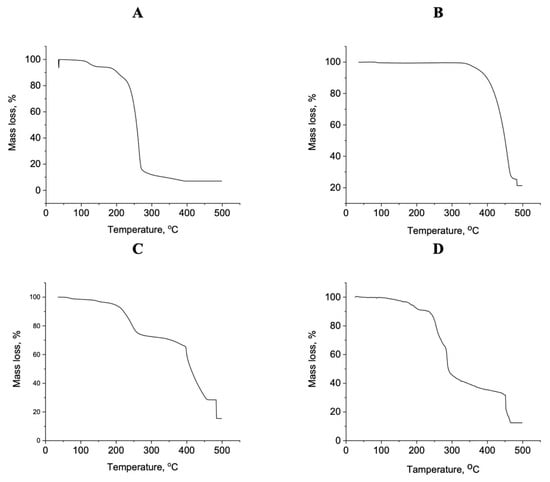
Figure 6.
TGA curves of (A): Mg(II), (B): Ca(II), (C): Zn(II), and (D): Fe(III)–pip complexes.

Table 4.
TGA data for the Mg(II), Ca(II), Zn(II), and Fe(III)–pip complexes.
3.5. Kinetics Data
Two often referenced techniques for calculating the kinetic thermodynamic parameters in the literature are Coats–Redfern [35] and Horowitz–Metzger [36]. In this study, these two approaches are used. The following equations were used in conjunction with well-known techniques to compute the activation energy, E; pre-exponential factor, A; entropies, ΔS; enthalpy ΔH; and Gibbs free energy, ΔG, from the TGA curves.
ΔH = E − RT and ΔG = ΔH − T ΔS
Table 5 includes a summary of the kinetic parameters for the second breakdown stage as well as the ionic radius of metal ions. These values were estimated using the Coats–Redfern and Horowitz–Metzger equations. The findings demonstrate that the values produced using different techniques are equivalent. The kinetic data collected using the two approaches agree with one another. Mg(II), Ca(II), Zn(II), and Fe(III) compound activation energies are anticipated to rise in correlation with a reduction in their radius [37,38,39,40]. The ligand may go closer since the ionic radius is less. As a result, the Fe(III) complex’s E value in the second stage is larger than that of the other complexes [37,40].

Table 5.
Kinetic thermodynamic parameters data of the pip complexes.
4. Conclusions
Four new solid complexes of pipemidic acid (pipH) with Mg2+, Ca2+, Zn2+, and Fe3+ were synthesized and characterized. Pipemidic acid acts as bidentate chelate through the oxygen atoms of both carboxylate and carbonyl groups of pyridopyrimidine ring. The spectroscopic data revealed that general formulas of pipH complexes are [Mg(pip)(H2O)3(Cl)].6H2O, [Ca(pip)(H2O)3(Cl)].2H2O, [Zn(pip)(H2O)3(Cl)].4H2O, and [Fe(pip)(H2O)2(Cl)2].6H2O. The number of water molecules with their locations inside or outside the coordination sphere were assigned via thermal analyses (TG, DTG). DTG curves refer to 2–3 thermal decomposition steps where the first decomposition step at lower temperature corresponds to the loss of uncoordinated water molecules followed by decomposition of pip molecule at higher temperatures. Thermodynamic parameters (E*, ΔS*, ΔH*, and ΔG*) were calculated from TG curves using Coats–Redfern and Horowitz–Metzger non–isothermal models. X-ray powder diffraction (XRD) and transmission electron microscopy (TEM) techniques were carefully used to assign properly the particle size of the prepared pip complexes.
Funding
The Deanship of Scientific Research at Princess Nourah bint Abdulrahman University, Riyadh, Saudi Arabia through Researchers Supporting Project number (PNURSP2023R35).
Data Availability Statement
Data recorded in the current study is available in all Tables and Figures of the manuscript.
Acknowledgments
The author is grateful to Princess Nourah bint Abdulrahman University, Riyadh, Saudi Arabia for funding this work through Researchers Supporting Project number (PNURSP2023R35).
Conflicts of Interest
The authors declare no conflict of interest.
References
- EMA. Disabling and potentially permanent side effects lead to suspension or restrictions of quinolone and fluoroquinolone antibiotics. Eur. Med. Agency 2018, 31, 1–3. [Google Scholar]
- Zaki, A.; Schreiber, E.C.; Weliky, I.; Knill, J.R.; Hubsher, H.J. Clinical pharmacology of oral cephradine. J. Clin. Pharmacol. 1974, 14, 1180. [Google Scholar] [CrossRef] [PubMed]
- Anacona, J.R. Synthesis and antibacterial activity of some metal complexes of beta-lactamic antibiotics. J. Coord. Chem. 2001, 54, 355. [Google Scholar] [CrossRef]
- Lozano, J.; Borras, J. Antibiotic as ligand. Coordinating behavior of the cephalexin towards Zn (II) and Cd (II) ions. J. Inorg. BioChem. 1987, 31, 187. [Google Scholar] [CrossRef]
- Abdel-Gawad, F.M.; El-Guindi, N.M.; Ibrahim, M.N. Cephalexin complexes with some 3d transition-metal ions. J. Drug Res. 1987, 17, 197. [Google Scholar]
- Helaleh, M.I.H.; Nameh, E.S.M. Selective kinetic study for the degradation of cephalexin in alkaline aqueous media. An. Quim. Int. Ed. 1998, 94, 160. [Google Scholar]
- Sorenson, J.R.J. Copper chelates as possible active forms of the antiarthritic agents. J. Med. Chem. 1976, 19, 135. [Google Scholar] [CrossRef]
- Brown, D.H.; Lewis, A.E.; Smith, W.E.; Teape, J.W. Antiinflammatory effects of some copper complexes. J. Med. Chem. 1980, 23, 729. [Google Scholar] [CrossRef] [PubMed]
- Williams, D.R. The Metals of Life; Van Nostrand Reinhold: London, UK, 1971. [Google Scholar]
- Ruiz, M.; Perello, L.; Ortiz, R.; Castineiras, A.; Maichlemossmer, C.; Canton, E. Synthesis, characterization, and crystal structure of [Cu (cinoxacinate) 2]· 2H2O complex: A square-planar CuO4 chromophore. Antibacterial studies. J. Inorg. Biochem. 1995, 59, 801. [Google Scholar] [CrossRef] [PubMed]
- Castillo-Blum, S.E.; Barba-Behrens, N. Coordination chemistry of some biologically active ligands. Coord. Chem. Rev. 2000, 196, 3. [Google Scholar] [CrossRef]
- Naglah, A.M.; Al-Omar, M.A.; Almehizia, A.A.; AlKahtani, H.M.; Bhat, M.A.; Al-Shakliah, N.S.; Belgacem, K.; Majrashi, B.M.; Refat, M.; Adam, A.M.A. Synthesis, thermogravimetric, and spectroscopic characterizations of three palladium metal(II) ofloxacin drug and amino acids mixed ligand complexes as advanced antimicrobial materials. J. Mol. Struct. 2021, 1225, 129102. [Google Scholar] [CrossRef]
- Refat, M.S.; Saad, H.A.; Gobouri, A.A.; Alsawat, M.; Adam, A.M.A.; Shakya, S.; Gaber, A.; Alsuhaibani, A.M.; El-Megharbel, S.M. Synthesis and spectroscopic characterizations of nanostructured charge transfer complexes associated between moxifloxacin drug donor and metal chloride acceptors as a catalytic agent in a recycling of wastewater. J. Mol. Liq. 2021, 349, 118121. [Google Scholar] [CrossRef]
- Alibrahim, K.A.; Al-Saif, F.A.; Alghamdi, M.; El-Shahawi, M.; Althubeiti, K.; Aljuhani, E.; Refat, M. Spectroscopic, molecular structural, thermal, biological and voltammetric characterization of Ru3+, Pt4+and Ir3+complexes of lomefloxacin drug. Lat. Am. J. Pharm. 2019, 38, 1077–1090. [Google Scholar]
- Naglah, A.M.; Al-Omar, M.A.; Almehizia, A.A.; Obaidullah, A.J.; Bhat, M.A.; Al-Shakliah, N.S.; Belgacem, K.; Majrashi, B.M.; Refat, M.; Adam, A.M.A. Synthesis, spectroscopic, and antimicrobial study of binary and ternary ruthenium(III) complexes of ofloxacin drug and amino acids as secondary ligands. Crystals 2020, 10, 225. [Google Scholar] [CrossRef]
- Refat, M.; El-Sayed, M.Y.; Hassan, R.F. Study of the chemical structure and the microbial effect of the iron(III) metal ions with four consecutive generations of quinolones in a nanometric form for the purpose of raising the efficacy of anti-bacterial and fungal drugs. Appl. Organomet. Chem. 2018, 32, e4195. [Google Scholar] [CrossRef]
- Al-Saif, F.A.; Alibrahim, K.A.; Alfurhood, J.A.; Refat, M. Synthesis, spectroscopic, thermal, biological, morphological and molecular docking studies of the different quinolone drugs and their cobalt(II) complexes. J. Mol. Liq. 2018, 249, 438–453. [Google Scholar] [CrossRef]
- El-Megharbel, S.M.; Hegab, M.S.; Manaaa, E.-S.A.; Al-Humaidi, J.Y.; Refat, M.S. Synthesis and physicochemical characterizations of coordination between palladium(II) metal ions with floroquinolone drugs as medicinal model against anticancer cells: Novel metallopharmaceuticals. New J. Chem. 2018, 42, 9709–9719. [Google Scholar] [CrossRef]
- Alibrahim, K.A.; Al-Saif, F.A.; Alghamdi, M.; El-Shahawi, M.S.; Moustafa, Y.M.; Refat, M.S. Synthesis, spectroscopic, thermal, antimicrobial and electrochemical characterization of some novel Ru(III), Pt(IV) and Ir(III) complexes of pipemidic acid. RSC Adv. 2018, 8, 22515–22529. [Google Scholar] [CrossRef]
- Alghamdi, M.T.; Alsibaai, A.A.; Shahawi, M.S.; Refat, M.S. Structural and chelation behaviors of new Ru(III), Pt(IV) and Ir(III) gatifloxacin drug complexes: Spectroscopic characterizations. J. Mol. Struct. 2017, 1130, 264–275. [Google Scholar] [CrossRef]
- Hussien, M.A.; El-Megharbel, S.M.; Refat, M.S. In-situ copper(II) complexes of some quinolone drug ligands were discussed for their molecular structures: Synthesis in binary solvent. J. Comput. Theor. Nanosci. 2017, 14, 561–576. [Google Scholar]
- Geary, W.J. The use of conductivity measurements in organic solvents for the characterisation of coordination compounds. Coord. Chem. Rev. 1971, 7, 81. [Google Scholar] [CrossRef]
- Chen, Z.-F.; Li, B.-Q.; Xie, Y.-R.; Xiong, R.-G.; You, X.-Z.; Feng, X.-L. Synthesis, crystal structure, and characterization of mixed-ligand complex of copper (I) with drug of norfloxacin and triphenyl phosphine:[Cu (PPh3) 2 (H-Norf)] ClO4. Inorg. Chem. Commun. 2001, 4, 346. [Google Scholar] [CrossRef]
- Wang, L.-Z.; Chen, Z.-F.; Wang, X.-S.; Li, Y.-H.; Xiong, R.-G.; You, X.-Z. 2D nanoporous molecular square grid: Manganese (II) norfloxacin complex. Chin. J. Inorg. Chem. 2002, 18, 1185. [Google Scholar]
- Chen, Z.-F.; Liang, H.; Hu, H.-M.; Li, Y.; Xiong, R.-G.; You, X.-Z. A neutral 2D nanosized molecular square grid: The first vanadium(II)coordination polymer of norfloxacin. Inorg. Chem. Commun. 2003, 6, 241. [Google Scholar] [CrossRef]
- Li, Y.-X.; Chen, Z.-F.; Xiong, R.-G.; Xue, Z.; Ju, H.-X.; You, X.-Z. A mononuclear complex of norfloxacin with silver (I) and its properties. Inorg. Chem. Commun. 2003, 6, 819. [Google Scholar]
- Nakamoto, K. Infrared and Raman Spectra of Inorganic and Coordination Compounds; Wiely: New York, NY, USA, 1978. [Google Scholar]
- Ross, S.D. Inorganic Infrared and Raman Spectra; McGraw Hill: London, UK, 1972. [Google Scholar]
- Deacon, G.B.; Phillips, R.J. Relationships between the carbon-oxygen stretching frequencies of carboxylato complexes and the type of carboxylate coordination. Coord. Chem. Rev. 1980, 33, 227. [Google Scholar] [CrossRef]
- Silverstein, R.M.; Bassler, G.C.; Morril, T.C. Spectroscopic Identification of Organic Compounds, 5th ed.; Wiley: New York, NY, USA, 1991. [Google Scholar]
- Anuradha, S.; Pramila, S. Synthesis, characterization, in-vitro anti-inflammatory and antimicrobial screening of metal (II) mixed diclofenac and acetaminophen complexes. Indian J. Chem. 2000, 39, 874–876. [Google Scholar]
- Cullity, B.D. Elements of X-ray Diffraction; Addison-Wesley, Reading: Boston, MA, USA, 1972; p. 102. [Google Scholar]
- Salavati-Niasari, M.; Mohandes, F.; Davar, F.; Mazaheri, M.; Monemzadeh, M.; Yavarinia, N. Preparation of NiO nanoparticles from metal-organic frameworks via a solid-state decomposition route. Inorg. Chim. Acta 2009, 362, 3691. [Google Scholar] [CrossRef]
- Velumani, S.; Mathew, X.; Sebastian, P.J. Structural and optical characterization of hot wall deposited CdSexTe1− x films. Solar Energy Mater. Solar Cells 2003, 76, 359. [Google Scholar] [CrossRef]
- Coats, A.W.; Redfern, J.P. Kinetic parameters from thermogravimetric data. Nature 1964, 201, 68. [Google Scholar] [CrossRef]
- Horowitz, H.H.; Metzger, G. A new analysis of thermogravimetric traces. Anal. Chem. 1963, 35, 1464. [Google Scholar] [CrossRef]
- Wendlandt, W.W. Thermal Methods of Analysis; Interscience: New York, NY, USA, 1964. [Google Scholar]
- Avsar, G.; Kulcu, N.; Arslan, H. Thermal behaviour of copper (II), nickel (II), cobalt (II) and palladium (II) complexes of N, N-dimethyl-N‣-benzoylthiourea. Tur. J. Chem. 2002, 26, 607. [Google Scholar]
- Sodhi, G.S. Correlation of thermal stability with structures for some metal complexes. Therm. Chim. Acta 1987, 120, 107. [Google Scholar] [CrossRef]
- Arslan, H.; Ozpozan, N.; Tarkan, N. Kinetic analysis of thermogravimetric data of p-toluidino-p-chlorophenylglyoxime and of some complexes. Therm. Chim. Acta 2002, 383, 69. [Google Scholar] [CrossRef]
Disclaimer/Publisher’s Note: The statements, opinions and data contained in all publications are solely those of the individual author(s) and contributor(s) and not of MDPI and/or the editor(s). MDPI and/or the editor(s) disclaim responsibility for any injury to people or property resulting from any ideas, methods, instructions or products referred to in the content. |
© 2023 by the author. Licensee MDPI, Basel, Switzerland. This article is an open access article distributed under the terms and conditions of the Creative Commons Attribution (CC BY) license (https://creativecommons.org/licenses/by/4.0/).